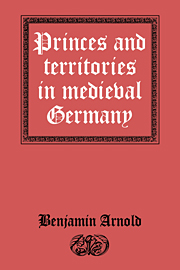Crossref Citations
This Book has been
cited by the following publications. This list is generated based on data provided by Crossref.
Airlie, Stuart
1995.
The New Cambridge Medieval History.
p.
431.
Arnold, Benjamin
1997.
Medieval Germany 500–1300.
p.
13.
Stacey, Robert
1999.
The New Cambridge Medieval History.
p.
11.
Toch, Michael
1999.
The New Cambridge Medieval History.
p.
375.
1999.
The New Cambridge Medieval History.
p.
835.
MacLean, Simon
2003.
Kingship and Politics in the Late Ninth Century.
Fulbrook, Mary
2004.
A Concise History of Germany.
Wilson, Peter H.
2004.
From Reich to Revolution.
p.
18.
2012.
Episcopal Power and Ecclesiastical Reform in the German Empire.
p.
1.
Schneidmüller, Bernd
2013.
Rule by Consensus.
The Medieval History Journal,
Vol. 16,
Issue. 2,
p.
449.
Cotts, John D.
2013.
Europe’s Long Twelfth Century.
p.
14.
Finley, Theresa S
and
Koyama, Mark
2016.
Plague, Politics, and Pogroms: The Black Death, Rule of Law, and the Persecution of Jews in the Holy Roman Empire.
SSRN Electronic Journal,
Taylor, Alice
2018.
FORMALISING ARISTOCRATIC POWER IN ROYALACTAIN LATE TWELFTH- AND EARLY THIRTEENTH-CENTURY FRANCE AND SCOTLAND.
Transactions of the Royal Historical Society,
Vol. 28,
Issue. ,
p.
33.
Lyon, Jonathan R.
2019.
Staufen and Plantagenets.
p.
151.
Graham-Goering, Erika
2020.
Princely Power in Late Medieval France.
Haldén, Peter
2020.
Family Power.
Donnelly, Jack
2021.
Levels, centers, and peripheries: the spatio-political structure of political systems.
International Theory,
Vol. 13,
Issue. 1,
p.
1.
Caferro, William
2022.
Comparative Economy and Martial Corporatism: Toward an Understanding of Florentine City Leagues, 1332–92.
Speculum,
Vol. 97,
Issue. 4,
p.
1073.
Mueser, Benjamin
2024.
Why Westphalia Still Matters: Territorial Rights under Empire.
International Studies Review,
Vol. 26,
Issue. 2,





